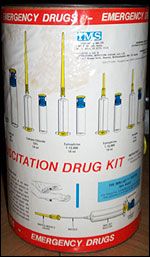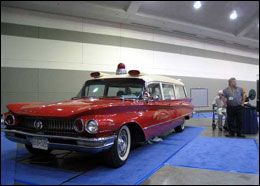By Maveric Vu
EMS1 Staff
 Photo courtesy of the NEMSMF The “Code in a Can” |
In 1979, Pope John Paul II visited Urbandale, Iowa for his first public ceremony in the United States. Paramedics and EMTs who worked the crowded event carried cylinder canisters that contained complete ALS cardiopulmonary resuscitation drugs.
It was aptly called “Code in a Can.”
Having not been widely distributed at the time, few cans remain intact today — except for one featured by the National EMS Museum Foundation, on loan from Tony Collins of Iowa.
“It’s one of my favorite pieces,” said Jules Scadden, former secretary with NEMSMF, “because it’s so unique.”
The non-profit NEMSMF has a clear mission — to memorialize and commemorate the history and individuals of EMS. This year, the foundation hopes to bolster its collection of artifacts and memorabilia, as well as cover growing operation costs during its first full-scale pledge drive.
“We make history everyday,” said Scadden, Paramedic Specialist in Iowa. “The kids who show interest in EMS are going to be the leaders of tomorrow — knowing what happened in the past is only way to improve the future.”
In May 2007, the foundation launched the first phase of its three-prong mission — a completely online “Virtual Museum.” The electronic catalog features hundreds of items, stories and pictures from the early “pioneer” days of EMS. The Web site organizes the catalog into different categories, from Early 1900s History to Specific Clothing History.
The second phase, to establish a “Traveling Museum” featuring certain items that would be displayed at trade shows and events across the country, was accomplished at EMS EXPO last October.
The ultimate objective is to build a “brick-and-mortar” museum to serve as a permanent display site for the NEMSMF collection. The tentative plan is to implement this phase over the next ten years, Scadden said.
Scadden hopes that the pledge drive will bring in funds to handle mounting storage costs and efforts to fully develop the traveling museum. While no fixed monetary goal has been set, the foundation’s main focus is to increase its presence within the EMS community, she said.
“We’ve vowed from the beginning to keep it a grassroots effort,” Scadden said. “From the manager to the street level provider, our museum will be for everyone.”
Interested parties can contribute to the foundation by either providing monetary support or by donating historical pieces unique to their region. Scadden described a homemade splint used by rural cowboys as an example of a potential donation item.
“These pieces were invented before actual regulation came into place,” she said. “Everything from this period is entrepreneurial. EMS is known for that.”
History, historically
The NEMSMF’s roots can be connected to a completely separate 1994 initiative launched by a group of dedicated providers, the To the Rescue Museum in Roanoke, Va.
Hailed as the first rescue museum in the nation, the concept was first tossed around casually among a group of volunteers. When the Virginia Association of Volunteer Rescue Squads donated $16,000 in seed money, initial talks solidified into an impressive museum collection.
According to former VAVRS president Tarry Pribble, an independent board was established and some funding was provided by the state. The Julian Stanley Wise foundation — named in honor of the Roanoke Rescue Squad, the first in the nation — was formed to oversee the museum’s operations.
Many museum pieces, such as training aids and an old crash truck, were donated by community members and enthusiasm remained high for years, Pribble said.
However, To the Rescue soon ran into financial issues. The board was unsuccessful at raising funds to cover increasing expenses and the state stopped paying for the museum’s rent, Pribble said.
“It was a very good idea; we just ran into hard economic times,” said Pribble, who was also a former board member on To the Rescue. “It was a very expensive venture.”
In 2006, To the Rescue closed its doors and turned over the museum collection to VAVRS, where the items remained in storage away from the public eye.
The start of NEMSMF
Lou Jordan, president of EMSBooks, accumulated quite a number of historic EMS textbooks throughout the years. Of particular interest to him are texts autographed by their original authors.
“It’s not the books in and of themselves, but the memory of the person, what they gave, and their friendship that gives the books value,” said Jordan, who is also vice president of the NEMSMF. “These books make up the past educational diary of EMS.”
Having sat on a number of national committees and participated on email discussion lists, it was natural that Jordan showed interest whenever talks of a national museum organization were sparked.
“I look at this stuff, and it’s definitely of value historically, and I think, ‘What good is it doing by sitting in my closet?’” Jordan said of his textbook collection. “Other people felt the same way, but there was just no plan or place for it to be shared.”
In June 2006, Jordan, Scadden and Bob Loftus, with EMTChief & Associates, began exchanging emails with early ideas for the foundation. Then, through a culmination of brainstorming, a core group of volunteers, and a $5,000 sponsorship by NAEMT, the NEMSMF was officially formed in August 2006.
The NEMSMF board of directors and staff, consisting of volunteers, formulated their game-plan: to compile and catalog historical pieces for the first leg of their mission — the online Virtual Museum.
The VAVRS, that was still storing the To the Rescue collection, found out about the formation of NEMSMF and transferred many of the pieces to the NEMSMF’s keeping in July 2007.
“Their mission is basically the same as it was for us,” Pribble said. “We wanted to be a part of preserving EMS, and this national effort is the best way to do it.”
Bringing history forward
 Photo by Maveric Vu 1960 “Flxible” Buick Premier Ambulance |
The NEMSMF is currently embarking on expanding the ambitious second phase — a traveling museum that would bring collection pieces to trade show events and cities across the nation.
“The reception has been fantastic,” Jordan said. “People are overjoyed at seeing this stuff.”
The NEMSMF collection was recently featured at the 2008 EMS Today conference in Baltimore at the end of March. The booth displayed a range of items, from a MCI “Orange Box” Telemetry Radio to a fully restored 1960 “Flxible” Buick Premier Ambulance, owned by Gene and Steve Lichtman, a Md. EMS provider.
For conference attendee Darren Lacroix, browsing the museum items brought him back to when he first started in the field.
“I used to use these,” Lacroix said, pointing to the 1974 Life Pak 4 by Physio-Control. “It’s good seeing it again.”
Lacroix, a paramedic instructor in Texas, remembered that the Life Pak’s stylus would overheat and cause the printout paper to smoke and burn.
“To look back at where you’ve been and where you are now and see the evolution,” Lacroix said. “It’s important.”
The traveling museum also displayed its collection at EMS EXPO in Orlando last October and other smaller events.
“Whenever our members are attending shows where ever, we try to bring stuff along and do double-duty,” Jordan said.
According to Jordan, the foundation hopes to implement a more consistent and stable system for the traveling museum by recruiting regional curators across the nation who would be able to bring the items to smaller shows and departments.
 Photo by Maveric Vu Darren Lacroix checks out the 1974 Life Pak 4 by Physio-Control |
However, the plan generates significant costs, such as shipping fees, booth space, storage, and travel and lodging. The museum currently has no funds available to reimburse its volunteers, Jordan said.
“My biggest goal would be to see an insurgence of the grass roots effort, of street providers taking an active interest in this membership,” Scadden said. “There is a long road ahead for this museum.”
The NEMSMF offers several levels of membership, from the $500 “Star of Life Member” to the basic museum member for $25. Each level offers different gift packages, which include items such as plaques, member patches, and other collectibles.
While the money generated from the membership drive would go toward sustaining the foundation, Scadden said she is more concerned about reaching out to the entire EMS community.
“As much as EMS people hate to hear the whole ‘hero’ thing, there is a level of humility we all feel,” Scadden said. “Everyday, you hear the stories of EMS providers who’ve gone above and beyond even their own physical ability, to do what they can for someone in need. We want to honor them.”
For more information on becoming a member or to browse the Virtual Museum, visit http://www.nemsmf.org/.

